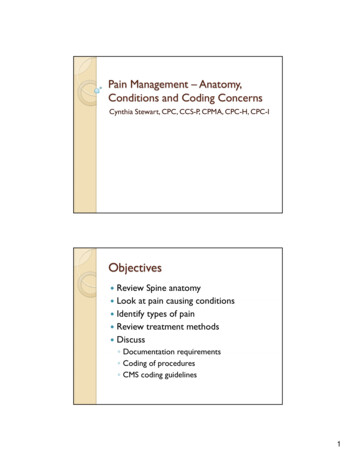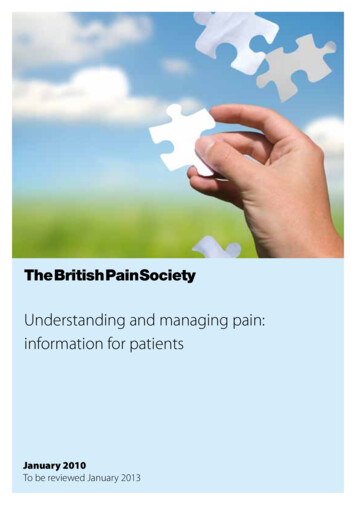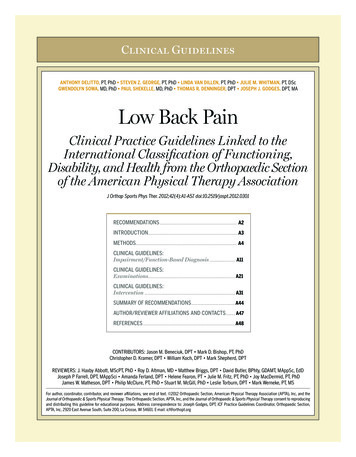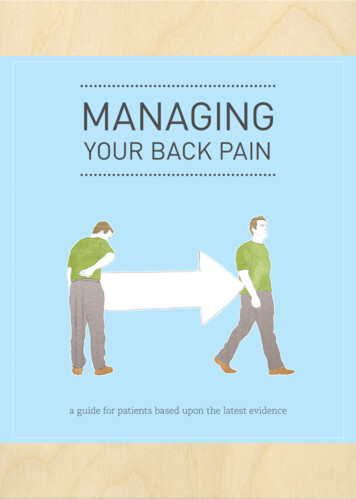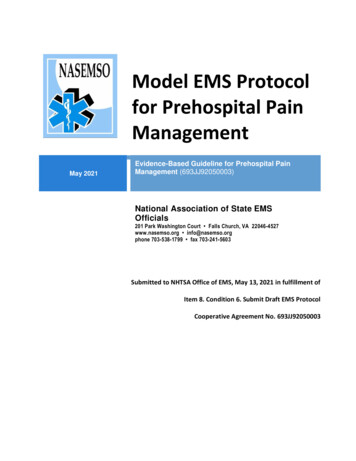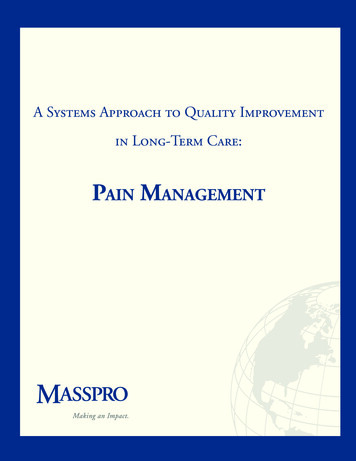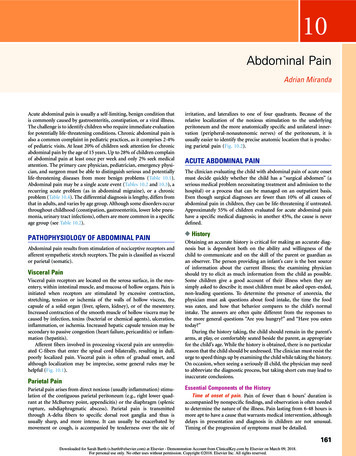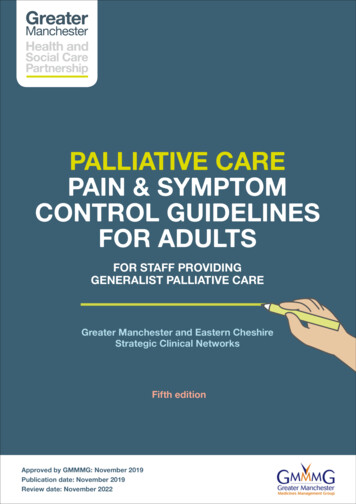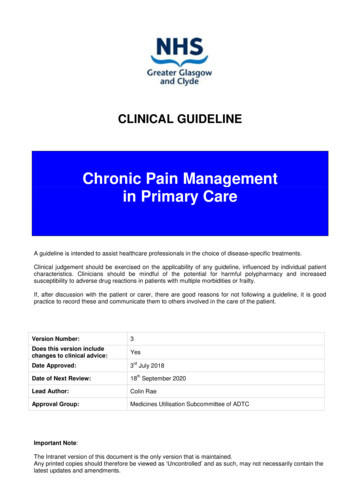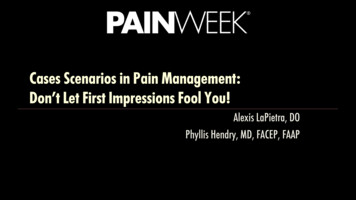
Transcription
Cases Scenarios in Pain Management:Don’t Let First Impressions Fool You!Alexis LaPietra, DOPhyllis Hendry, MD, FACEP, FAAP
Disclosures Alexis LaPietra, DO–Nothing to disclose Phyllis Hendry, MD–Principal investigator, Pain Assessment and Management Initiative (PAMI), a free access onlineeducational site funded by Florida Medical Malpractice Joint Underwriting Association
Learning Objectives Review clinical cases that illustrate how to manage difficult pain management scenariosin the emergency department including high risk populations such as elderly andimpaired patients Describe the importance of vital signs in complex pain emergency cases. List ways to address patient safety aspects of ED pain management cases from triage todischarge and tricks for avoiding bad outcomes
Case Context Pain is a component of the presenting complaint in up to 78% of ED visits Medical schools provide minimal training in pain management Most EDs are overcrowded and patients have a variety of acuity levels, diseases,resources and ages–Toddler in a MVC with fractures to an elderly patient with arthritis and back pain Emergency physicians are under tremendous pressure to see patients rapidly (triage todischarge time) while balancing care for patients in pain and other emergent priorities
Triage Trickery
Triage Trickery 18 YO BM transported by rescue for sickle cell pain. Paramedic to triage nurse–“Took one dose of pain meds about 4 hours ago. Didn’t even try anything else. You know theusual. Just looking for some IV drugs. Hasn’t even called his doctor ” Triage nurse to resident doctor and nursing staff–“18 yo SS patient in room 4 on Norco, looking for drugs” Resident to attending physician–“ Frequent flyer-SS drug seeker in room 4, doesn’t look like he’s in pain” Attending physician: goes into room with preconceived attitude
Triage Trickery: The Rest of the Story! Never hospitalized before for pain Doesn’t have SS disease, has a different hemoglobinapathy Has old Rx for Norco but left in city where he attends college and has a hematologist Visiting grandparents for summer vacation Honor student
Triage Trickery Summary ED triage done very rapidly and under pressure to decrease waiting times EMS personnel often have limited time to get history Emergency care providers have potential for bias depending on patient population,years of experience, and previous cases Burn out Always take your own history Ask open ended questions
The Devil is in the Discharge Planning Medico-legally, what happens to the patient after ED discharge is as important as whathappens in the ED Patient must be deemed safe for discharge after receiving analgesic or sedativemedications or procedural sedation and analgesia (PSA) A discharge pain plan is crucial–Unfunded patients–Long delays for appointment–Limited time to formulate and discuss discharge planning and education
The Devil is in the Discharge Planning: Case 1 74 YO BM arrives via EMS with left hip pain after falling from his front porch steps. EMS report: “patient discharged an hour ago from your facility with anklesprain took a cab home and stumbled while trying to walk up porch steps withcrutches. Now complaining of left hip pain.” ED History: patient initially thought to have a fracture on arrival and given morphine PMH: has fallen 3 times over the past 2 months 2nd ED visit- hip fracture, abrasions and contusions
The Devil is in the Discharge Planning: Case 2 ED 7 am shift change Recently discharged 18 yo carried in by boyfriend after “passing out” in hospitalparking lot and hitting her head Now pale, sleepy, oriented X 3, face bleeding, . Seen in ED overnight for miscarriage, bleeding and abdominal pain Received morphine at 5 am, discharged at 6:30 am
The Devil is in the Discharge Planning: Case 2 Cont’d On further history and chart review–Vital signs not repeated at discharge–Patient had nothing to eat or drink for 12 hours–Patient had no transportation home- was walking from ED to bus stop to wait for first bus
The Devil is in the Discharge PlanningTake Home Points “Road test” patient Key discharge patient safety determinants:discharge vital signs, ability to tolerate fluids,pain level, transportation, ability to care forself or reliable care giver Discharge medication review and follow-upplanPAMI Pain Management and Dosing Guide: http://pami.emergency.med.jax.ufl.edu
Between Triage and DischargeED Case Scenarios
Case 3 18 M h/o schizophrenia who is transferred from group home to the ED for abdominalpain. He will not let you examine him and he is rolling around on the floor–Security has to place him in a bed. He is agitated and will not answer any of your questions.–Unable to get vitals but you notice he is diaphoretic and breathing fast
Case 3 Cont’d Group home counselor arrives, states he is very histrionic he just needs to be sedated, heis always complaining of abdominal pain Patient receives Ativan 2 mg IM–VS- HR:120 BP:105/80 RR:29 T:99.9F O2: 100% RA Past ED visits are mostly for abdominal pain, last CT was a year ago
Case 3 Cont’d Order some labs Imaging ?–XR vs CT abd/pelvis
Case 3 Cont’d Some of the other staff say he is a “regular” he always just gets sedated You still cannot examine him after the Ativan. He is screaming he does not want to behere Next step?–More sedation?–Let him relax, his vitals signs were not terribly abnormal
Case 3 Cont’d Ativan 2 mg IM Haldol 5 mg IM In 15 minutes you are able to examine him and get lab work. Abdomen is rigid and he grimaces with superficial palpation in all quadrants HR 135 BP 95/60
Case 3 Cont’d WBC 14,000–Bands 25% Lactate 9.4 CO2 11 Now what?
Diagnosis CT: Volvulus Disposition–OR
Case 4 37 M with history of developmental delay, nonverbal, is brought in by caretaker forchest pain. Patient is pacing and rubbing his chest and refusing to eat. Very anxious.Caretaker says he was fine, they were watching TV and eating tortilla chips VS- HR 140 BP: 167/89 RR: 25 T: 98 O2: 100% RA Physical exam including posterior pharynx is unremarkable
Case 4 Cont’d Patient receives viscous lidocaine,bismuth subsalicylate, and famotidine Chest XR- appears normal
Case 4 Cont’d Patient is given midazolam 4 mg IM Patient is getting more and more agitated and now is becoming a bit violent Discussion to do labs
Case 4 Cont’d WBC 12,000 All other labs including troponin are normal Repeat VS- HR: 135– EKG: sinus tachycardia, otherwise normal CT scan?– Patient is not cooperative, additional sedation? Pain medication?
Case 4 Cont’d CT chest Pneumomediastinum Disposition–Endoscopy suite for EGD–Found to have large esophagealtear with a small edge of dorritoembedded in wall
Case 5 80 F presents with mild right lateral rib pain s/p mechanical trip and fall up the stairs,no LOC. Reports after fall she is getting “dizzy” when she stands up–PMHx: HTN Meds: norvasc–VS HR:97 RR:16 T:98.9 O2: 100%RA–BP supine: 115/90 BP standing: 90/50–PE: no obvious injury, mild right chest tenderness, abdomen benign
Case 5 Cont’d Labs sent, EKG done (normal), CXR normal–Observation for syncope evaluation? Labs are normal, you call over to OBS and tell them the case Resident wants to do a FAST for “completeness”
Diagnosis FAST Exam–Grade IV liver laceration Disposition–OR
Don’t get Fooled by .Special Populations Psychiatric and Special Needs patients– Difficult to obtain history Broad differential– May be uncooperative with exam Remember to control pain! Sedate if necessary Fully evaluate and perform thorough work up– Must rule out medical emergencies Do not presume there is no underlying medical disease Trust vital signs Do not be afraid to do a higher resource work up
Don’t be Fooled by . Special Populations Geriatric patients–Unreliable vital signs–Unreliable physical exam–Unreliable pain perception Err on the side of caution–Get imaging–Frequent re-evaluation–Ensure follow up or place in OBSDaoust JEmMEd 2016
Case 6 50 M presents after solo car MVC with head laceration. States he walked 2 miles to localcommunity hospital. He has no complaints but admits to EtOH. VSS and no PMHx, smells of alcohol Head lac is repaired with 2 staples and ER team is letting him “sleep it off” No trauma activation because there are only minor injuries and no focal neuro deficits
Case 6 Cont’d An hour later the nurse grabs you and says the drunk guy is waking up and he iscomplaining he cannot get up to pee PE: 1/5 strength in bilateral lower extremities, he has labored breathing and c/o SOB 90 minutes into ED course Trauma ALERT is placed
Case 6 Cont’d Patient is unable to move extremities Patient is intubated for severe respiratory distress Patient is sent off for pan scans
Case 6, cont’d Fracture dislocation of C5 on C6, with cordimpingement Neurosurgery on for spine came in fordecompression
Case 7 29 M jumped off of a 2 story roof while evading police. Was eventually apprehendedand brought to ER by police to be medical cleared Patient ambulating without complaint just a minor limp, said he twisted his ankle He admits to using PCP
Case 7 Patient relatively uncooperative, does not want to get undressed–Gross physical exam reveals no apparent injuries–He asks for pain medication and he gets ibuprofen 600 mg After an hour he urinates and has gross hematuria You disrobe him, see blood at the meatus and when you palpate his pelvic he c/o severepain on the LEFT, he cannot move his LLE secondary to pain
Ouch! Pelvic XR–LEFT superior and inferior ramifractures–Uretheral injury Disposition–Trauma service
Don’t be fooled by . Alcohol and drugs–Patient history can be unreliable–Patient exam can be unreliable assume the worst and DISROBE Must re-eval when sober–When mechanism of injury is severe (eg: high speed MVC or fall from height) treat patient as atrauma until proven otherwise–EtOH and drugs can significantly compromise pain tolerance and appreciation for life/limbthreatening injury
Case 8 33 F presents with c/o abdominal pain. She states she is maintained on opiates at home, forchronic abdominal pain and lupus. She admits she has been taking more than normal,because the pain has been a bit different, and she ran out She states it feels just a little worse than her “normal pain” and asks for hydromorphone IVand a script upon discharge VS- HR: 125 BP: 156/80 RR: 22 T: 99.7 F O2: 100% RA PE- moderate abdominal tenderness diffusely
Case 8 Cont’d She gets 1 L NS, hydromorphone 2 mg IV, and ondanestron 4 mg IV Repeat VS- HR: 129 BP: 100/70 Patient states pain is severe now and getting worse Physical exam is unchanged Additional pain meds? You send off labs
Case 8 Cont’d Lactate 7 WBC 25,000 Again physical exam reveals moderate tenderness in abdomen but she is complainingthe pain is continuing to worsen despite hydromorphone and crying for more painmedication
Case 8 You get the CT Ischemic bowel due to thrombus in SMA–She had 7 cm of ischemic bowel resected
Case 9 62 F presents with acute on chronic left hip pain. She states she has had persistent painever since her THA 2 years ago. Something with a “D” works for her when she comes toED and she’d like a dose VS- HR:110 BP: 167/89 RR:20 T: 101.9 O2: 100% RA She cannot range left hip but states that’s normal for her. She states she is hot becauseshe was sitting outside in the sun. She again states she needs the “D” medication
Case 9 Cont’d XR- hardware in place, no dislocation Hydromorphone 1 mg IV WBC 18,000 CRP 7 You want to do a CT of the hip, she refuses states she just wants a script for home
Case 9, cont’d You argue with her, you give her a second dose of hydromorphone She agrees with CT CT- exudative fluid collection around hardware consistent with ABSCESS
Don’t be fooled by . Chronic pain patients–Look for red flags Vital Signs Lab work Change in character of pain Increased frequency of pain meds at home–Perform thorough physical exam–Pain medication is therapeutic not diagnostic
Case 10 67 M presents with RUQ abdominal pain. VSS no PMHx Labs unremarkable, mild tenderness RUQ US normal Patient discharged home with acetaminophen
Case 10 Cont’d He returns 2 days later, pain is worse and unrelenting VSS, moderately tender in RUQ Morphine 5 mg IV CT abd/pelvis- unremarkable for acute pathology, he feels better Discharge home with tramadol
Case 10 Cont’d He returns again 2 days later (Day 6) pain is excruciating VSS, states Tramadol is not helping On ROS- he does state he has a new rash that was there 4 days ago but no oneasked or looked
Case 10 Cont’d Physical Exam–Shingles Disposition–Home with Acyclovir
Don’t be Fooled by .Fully Clothed Patients Expose every patient–Full inspection is important Genitourinary, Axillary, and Skin–Avoid extensive work-up–Uncover emergency conditions otherwise thought to be benign
EyeOrbital CellulitisRuptured GlobeEarMalignant Otitis ExternaThroatLudwig’s AnginaRetropharyngeal AbscessChest/BackAortic DissectionAbdomenMesenteric IschemiaAbdominal Aortic AneurysmSkinNecrotizing FasciitisExtremityCompartment SyndromeArterial Occlusion
Take Home Messages Beware of EMS and triage histories- take your own Do not be afraid to order a higher resource work up in geriatric, EtOH/drug abuse,psychiatric, or special need patients Vital signs are an important predictor of “badness” ALWAYS fully expose the patient
Take Home Messages Give the benefit of the doubt to chronic pain patients and remember pain medication isnot diagnostic ED discharge planning is critical yet there are limited resources and time Adverse events often occur soon after discharge or transition of care to another facilityor part of the hospital A large proportion of ED patients have no insurance and no PCP plus comorbiditiesmaking them high risk for “bounce backs”
Questions?Thank You! phyllis.hendry@jax.ufl.edu Emergency care providers, residents andstudents often learn best by case scenarios We welcome your interesting, de-identifiedcases to use in our mission of improving EDand EMS pain education and pain managementin the patients we serve 365/24/7 lapietra@sjhmc.org
She states she has had persistent pain ever since her THA 2 years ago. Something with a "D" works for her when she comes to ED and she'd like a dose VS- HR:110 BP: 167/89 RR:20 T: 101.9 O2: 100% RA She cannot range left hip but states that's normal for her. She states she is hot because



